130 Years of the Victoria Building
Posted on: 13 December 2022 by Kim Fisher, VG&M Visitor Services Team in 2022
The Victoria Building officially opened on 13th December 1892 and this year we celebrate our 130th anniversary.
Although the building has always been a part of the University of Liverpool it has had many different uses over the years and in this blog we will look at the history of a few locations located on the ground, first and second floors. By using 20th century photographs held in Special Collections and Archives and 21st century technology from the Mobile and UI team, these historical areas of our building will come to life.
The VG&M Exterior
The exterior of the Victoria Building animation - turning the original black and white photograph into a colourised image.
Construction of our iconic redbrick building started in 1889 and Alfred Waterhouse was chosen as the building’s architect. In the animation above we see the completed structure circa 1892 looking down Brownlow Hill towards the town centre.
This area of Liverpool had predominantly been where the hospitals, workhouse and asylum had been and this area of the city has changed so much over the past 130 years. The Ashton Street Asylum was demolished around 1914 and became part of the University quadrangle, Liverpool Workhouse was demolished in 1931 to make way for the construction of Liverpool Metropolitan Cathedral and many other buildings have been repurposed or newly constructed as part of the campus that we see today.
Buildings from Liverpool Workhouse can be seen on the left of the image and the wide cobbled streets without any passing traffic contrast the view that we see today in 2022. The only thing that hasn’t changed in this view is our Grade II listed Victoria Building which is now the flagship building for the university, proudly standing 130 years after it was first built in our ever-changing city.
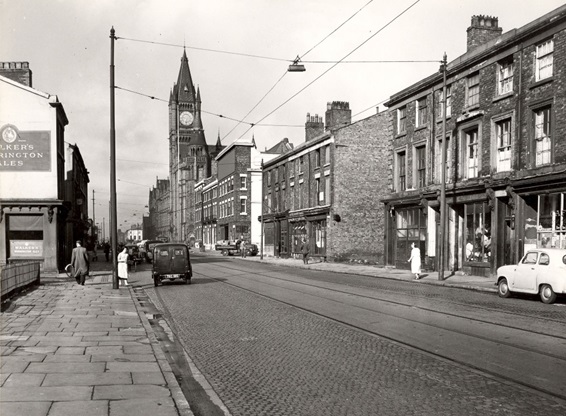
Brownlow Hill, circa 1960
The Ground Floor Entrance Hall
Ground Floor Entrance Hall animation - featuring flickering electric lighting, a roaring fire and moving clock hands.
This animation shows the entrance hall in the 1890s. Not much has changed from today’s view, apart from an addition of the Waterhouse Café and new lighting fixtures. This space was built for show – it was a grand and highly decorated space to impress visitors as they walked in through the main entrance doors which are now situated behind the lift shaft.
In winter the fire would have been lit to help warm this space but over the years the coal and dust from the large fireplace would have settled on the tiles and surrounding space. Students complained that if you touched the tiles, grime would come off onto the fingers and the clock above the fireplace was also known to jump erratically with the porter constantly having to adjust the time.
“Having passed through the period when people imagined that the Victoria building represented the highest achievement of the human brain in the art of architecture. I'm pretty sure to meet with agreement, if I condemn the mantelpiece of the Great Hall…”– Student Magazine circa 1900
Student accounts in 1907, 15 years after the building was constructed, shows how fashions and attitudes had already changed in relation to architectural designs. A student stated that they had expected something finer for the entrance hall and thought the tiles and colour to be incredibly ugly.
Today however, our visitors gasp in awe at our gorgeous gothic interior and the Waterhouse Café now fills this vast space where visitors can eat delicious food whilst drinking in the exceptional culture.
The First Floor Women’s Common Room
The Women’s Common Room animation - turning the original sepia image into the modern fireplace. A kettle boils in front of the fire and the carved animals slowly start to come to life.
This animation begins with a photograph of the Women’s Common Room circa 1892 that slowly comes to life to reveal the room today and some of the carved creatures coming to life.
In the original photograph, a kettle is positioned in front of the fireplace and there are a few pieces of wooden furniture around the room. The women's rooms were originally equipped with furniture designed and supplied by both Alfred Waterhouse and Principal Gerald Rendall who had a lot of input into the furniture for his students.
However, many of the items that the male-led team had arranged for the female students’ rooms had not been designed with women in mind; including mirrors that were positioned too high and lockers that did not have sufficient space.
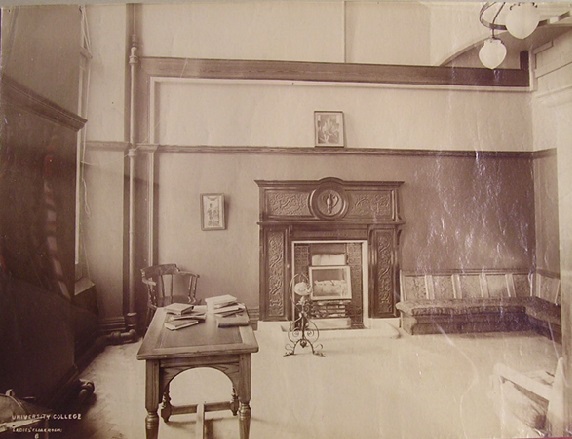
The original photograph from 1892
To make their rooms a little more comfortable, the female students set up a furnishing committee in December 1892 to raise money to buy their own furniture. By the Autumn term of 1893 this room was furnished with three easy chairs, a rug, two plants, a tea service, embroidered Japanese screens, flower stands with freshly cut flowers and a portrait of the novelist and poet George Meredith by G.F. Watts. A beautiful large mirror and much needed noticeboards were later additions.
“The Victoria building has at last received us. And in this new era of college life, our feet are indeed set in a large room. Discomfort, and general dinginess are discouragements no longer and the inspirations of our beautiful surroundings, has been an important factor in the development of these hopeful signs of the stare of a new energy, which marked the closing scenes in the old college.” Student Magazine, Women’s Section, 17 October 1892.
It appears that there were a lot of familial connections associated with our walnut fireplace. It was designed by University College Liverpool student Eleanor Gordon (1884-1888) who would have originally studied in the converted asylum building. After graduating, Eleanor married Johan Frederik Caroe, the elder brother of architect William Caroe. William was a major figure in the Arts and Crafts movement and the fireplace’s design is also typical of the movement; displaying natural forms and the flowing curves of vines and leaves that represent the tree of life and tree of knowledge. The design itself closely resembles carvings seen on ‘The Throne of Maximian’ which is now on display at the Archiepiscopal Museum, Ravenna. It is possible that Eleanor was inspired by the chair’s design and incorporated it into the fireplace at University College Liverpool.

Close up of the Throne of Maximian that may have inspired our fireplace
The fireplace was carved by Mrs Florence MacCunn, wife of the professor of Philosophy and Miss Helen Caroe, who was William and Johan’s sister. Principal Gerald Rendall was also a kinsman of William Caroe's wife Grace and he had admired a peacock that Mrs MacCunn had carved in her mantelpiece at home, which could be why the peacock is also at the centre of our fireplace.
The First Floor Senate Room
The Senate Room animation - figures from the original sepia image are colourised and start to move.
The original Senate room photograph was taken circa 1920 and shows the members of the university Senate seated around a table and being addressed by the Vice-Chancellor, Dr Adami, with the Registrar Mr Edward Carey on his right and the Librarian Dr John Sampson, fourth from right.
The university Senate is the deliberative body that discusses policies and changes that relate to the university. The Senate Room in the Victoria Building was originally where the Senate held their meetings. The first meeting of the Faculty of Arts was held on 4 December 1896 in this room until university administration was moved to Senate House in Abercromby Square in 1968.
The room has an oak panelled ceiling, paid for by Henry Tate and his initials are inscribed on the corbels in this room.
The room was furnished with two tables, chairs, a settee, an elaborate fireplace and a central bookcase. A reading room was connected by an archway and had three small table but today, only the bookcase and ceiling are still intact.
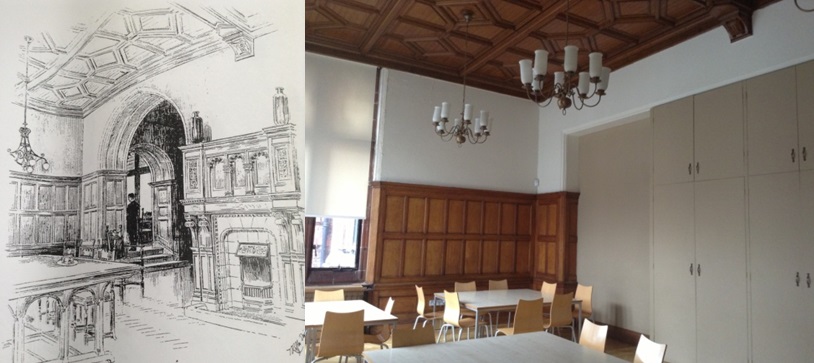
Left - Ernest Coffin illustration showing the Senate room circa 1892 with the fireplace and connected reading room. Right – the same view today.
Today this room is not accessible to the general public unless as part of an activity arranged by the VG&M. In more recent years, this room has been used by school groups and also The Redbrick Writers who use our building once a month for creative writing.
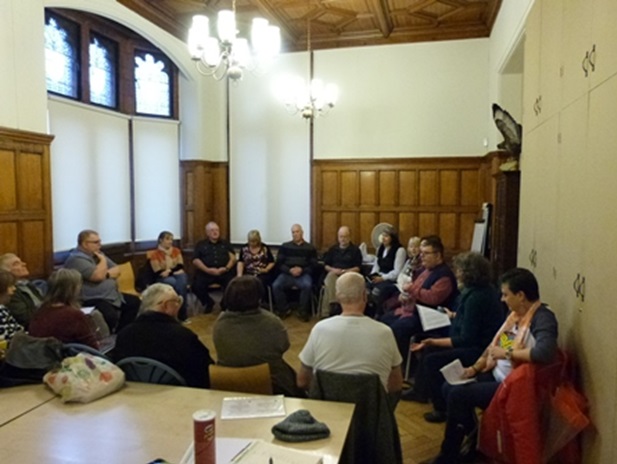
The Redbrick Writers using the Senate Room, circa 2015
For our 130-year anniversary, The Redbrick Writers have compiled an anthology inspired by our building and its history. The works include creative writing, poems and short stories.
Redbrick Writers - Celebrating 130 Years of the Victoria Building
“Everybody loves meeting at the VG&M so the building is always in our hearts! For this project we talked about the building and looked at the photos in gallery 3. I asked everyone to look about the entrance hall and to make notes on what interested them and then to give me a couple of phrases which I would see if I could combine in a group poem.” – Shirley Jones, Redbrick Writers
The Second Floor Tate Library
Tate Library Animation - the figure in the library starts to write at his table and the library changes to a view of the Tate Hall Museum from 2019.
This space was funded by and named after the sugar merchant and philanthropist Henry Tate and his generous donations included £20,000 for the construction of this part of the building and a further £5,000 for books.
The room could hold up to 80,000 volumes but by 1938 the library was moved to the Harold Cohen library which could better accommodate the students of a rapidly expanding university.
By 1939 it was decided that the Tate Library would become a function space for the university and from April-May 1939 a report was provided by Lionel Budden, Professor of Architecture, on how improvements could be made to the Tate.
Budden commented that the room had very insufficient and uneven distribution of light due to the defects in design of the open roof and obtrusive tie beams and king posts which performed very little to the main structure. It was decided to remove these beams and add heraldic motifs to the corbels carrying the tie beams and one of the crests selected was the Tate family crest. The metal gallery that took library users to additional shelves in the roof alcoves was also removed because it was felt that it would no longer be required and would only detract from the proposed panelling and reduce the apparent height of the room.
The space was used for many different functions over the years, many past students recall it as an examination hall up until the mid-2000s before conversion of the VG&M began.
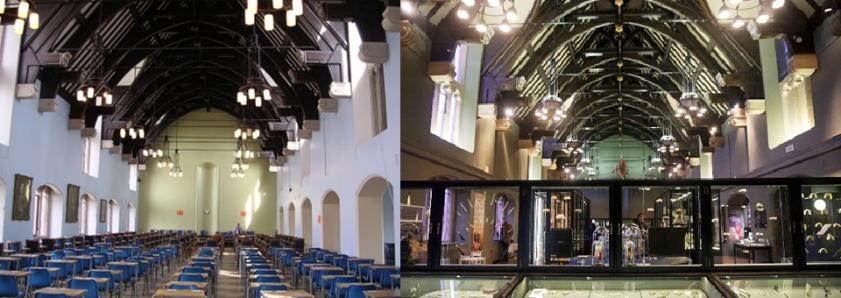
Left – examination hall circa 2004, Right – The Tate Hall Museum circa 2019.
The Tate Hall Museum opened in 2008 and has housed the University of Liverpool’s Heritage Collections, displaying many artefacts collected by university departments over the past 140 years. Although currently closed to the public for roof refurbishment, the space will open again in 2024.
After 130 years, our building is still very much at the heart of campus life and we hope that with the ongoing careful refurbishment works that we will be around for another 130 years to come.
Keywords: VG&M, Victoria Gallery and Museum, University of Liverpool History, 130 years, University College Liverpool History, Alfred Waterhouse.